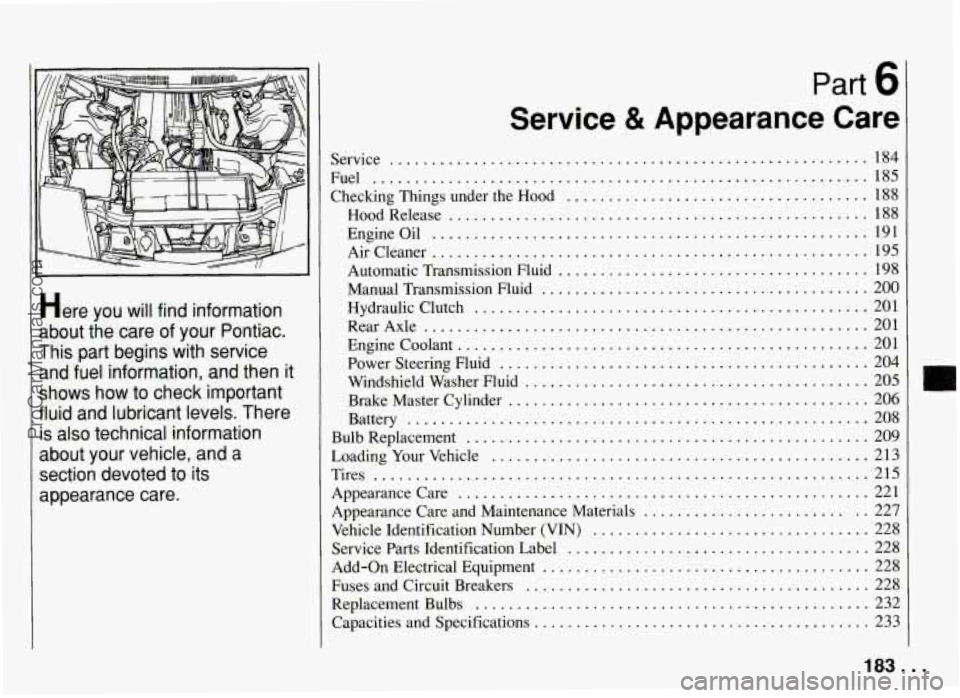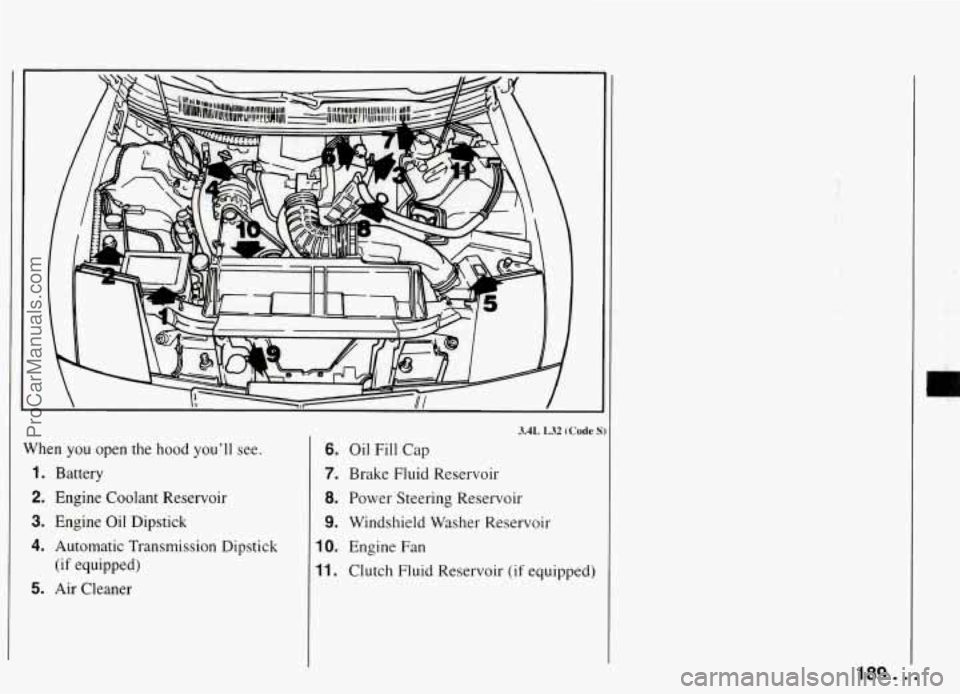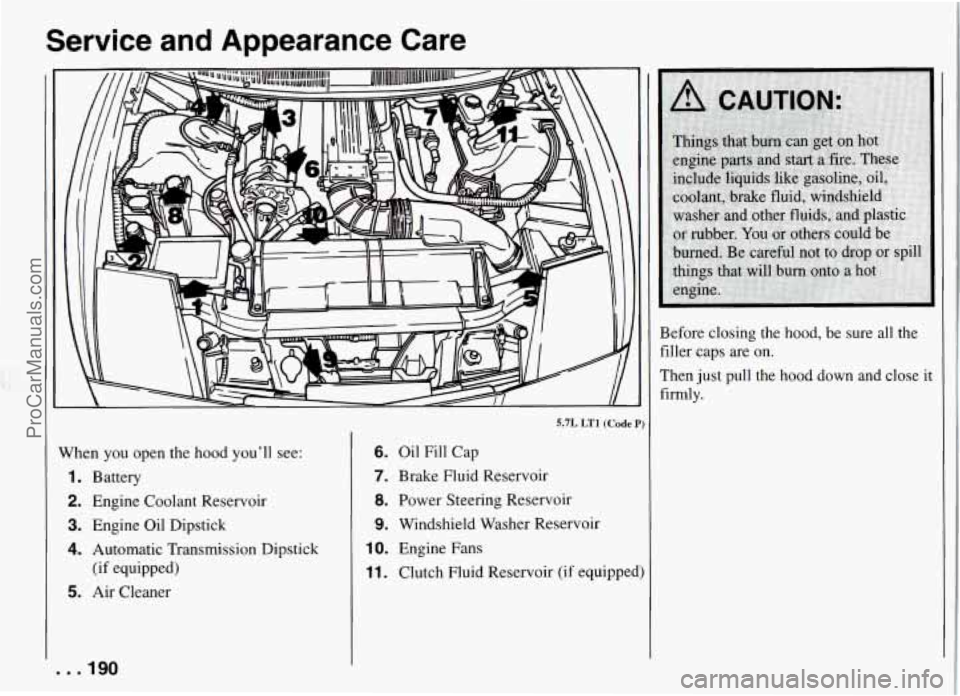power steering PONTIAC FIREBIRD 1994 Owners Manual
[x] Cancel search | Manufacturer: PONTIAC, Model Year: 1994, Model line: FIREBIRD, Model: PONTIAC FIREBIRD 1994Pages: 290, PDF Size: 14.84 MB
Page 52 of 290

D
Ignition Switch
With the ignition key in the ignition
switch, you can
turn the switch to five
positions:
Acc (A): Position in which you can
operate your electrical power accessories.
Press in the ignition switch as you
turn
the top of it toward you.
LOCK (B): The only position in which
you can remove the key. This locks your
steering wheel, ignition and automatic
transmission.
If you have an automatic transmission,
tht
ignition switch can’t be turned to
“LOCK’ unless the shift lever is in the
“P’ (Park) position.
Off (C): Unlocks the steering wheel,
ignition and automatic transmission, but
does not send electrical power to any
accessories. Use this position if your
vehicle must be pushed or towed. A
warning tone will sound if you open the
driver’s door when the ignition is in
“Off”
and the key is in the ignition.
Run (D): Position to which the switch
returns after you start your engine and
release the switch. The switch stays in the
“Run” position when the engine is
running. But even when the engine is not
running, you can use “Run” to operate
your electrical power accessories and to
display some instrument panel warning
and indicator lights.
Start (E): Starts the engine. When the
engine starts, release the key. The ignition
switch will return to “Run” for normal
driving.
Note that even if the engine is not
running, “Acc” and “Run” allow you to
operate your electrical accessories, such
as the radio and ventilation fan.
:I
Ley Release Button: If you have a
lanual transmission, your ignition lock
as a key release button.
You must press
le button before you can take your key
ut of the ignition lock.
51 . .
ProCarManuals.com
Page 69 of 290

Features and Controls
The switch for the driver’s window has an
5xpress Down feature. Quickly press and
aelease the switch for the driver’s window
md the window will lower completely.
fou can also open the driver’s window
my amount by pressing the switch again
while the window is in the Express Down
node when it has lowered to the position
IOU want.
Power Windows (Option)
With power windows, switches on the
door control each window when the
ignition is on or when RAP is present.
(See “Retained Accessory Power” in
the Index.)
You can
also open the passenger window
any amount by pressing the switch and
releasing it when the window has
lowered to the position you want.
... 68
Horn
ro sound the horn, press either horn
;ymbol on your steering wheel.
ProCarManuals.com
Page 133 of 290

Your Driving and the Road
Braking in Emergencies
Use your anti-lock braking system when
you need to. With anti-lock, you can steer
and brake at the same time.
In many
emergencies, steering can help you more
than even the very best braking.
Steering
Power Steering
If you lose power steering assist because
the engine stops or the system
is not
functioning, you can steer but it will
take much more effort.
Steering Tips
Driving on Curves
It’s important to take curves at a
reasonable speed.
A lot of the “driver lost control” accidents
mentioned on the news happen on curves.
Here’s why:
Experienced driver or beginner, each of
us is subject to the same laws of physics
when driving on curves. The traction of
the tires against the road surface makes it
possible for the vehicle to change its path
when you turn the front wheels. If there’s
no traction, inertia will keep the vehicle
going in the same direction. If you’ve
ever tried to steer a vehicle on wet ice,
you’ll understand this.
The traction you can get in a curve
depends on the condition of your tires
and the road surface, the angle at which
the curve is banked, and your speed.
While you’re in a curve, speed is the
one factor you can control.
Suppose you’re steering through a sharp
curve. Then you suddenly accelerate.
Both control systems
- steering and
acceleration
- have to do their work
where the tires meet the road. Unless you
have traction control and the system is
on, adding the sudden acceleration can
demand too much of those places.
You
can lose control.
What should you do if this ever happens?
Ease up on the accelerator pedal, steer the
vehicle the way you want
it to go, and
slow down.
Speed limit signs near curves warn that
you should adjust your speed. Of course,
the posted speeds are based on good
weather and road conditions. Under less
favorable conditions you’ll want to go
slower.
[f you need to reduce your speed as you
approach a curve,
do it before you enter
the curve, while your front wheels are
straight ahead.
Try to adjust
your speed so you can
”drive” through the curve. Maintain a
reasonable, steady speed. Wait to
accelerate until you are out of the curve,
and then accelerate gently into the
straightaway.
. . ,132
ProCarManuals.com
Page 184 of 290

I I
Here you will find information
about the care of your Pontiac
.
This part begins with service and fuel information. and then
it
shows how to check important
fluid and lubricant levels
. There
is also technical information
about your vehicle. and a section devoted
to its
appearance care
.
Part b
Service 8t Appearance Care
Service .........................................................
Fuel ...........................................................
Checking Things under the Hood ....................................
HoodRelease ..................................................
184
185
188
188
Engineoil
.................................................... 191
Aircleaner
.................................................... 195
Automatic Transmission Fluid
..................................... 198
Manual Transmission Fluid
....................................... 200
Hydraulic Clutch
............................................... 201
RearAxle
..................................................... 201
Enginecoolant
................................................. 201
Power Steering fluid
............................................ 204
Windshield Washer Fluid
......................................... 205
Brake Master Cylinder
........................................... 206
Bulb Replacement
................................................ 209
Battery
....................................................... 208
LoadingYourVehicle
............................................. 213
Tires
........................................................... 215
Appearance Care
................................................. 221
Appearance Care and Maintenance Materials
.......................... 227
Vehicle Identification Number (VIN)
................................. 228
Service Parts Identification Label
.................................... 228
Add-on Electrical Equipment
....................................... 228
Fuses and Circuit Breakers
......................................... 228
ReplacementBulbs
............................................... 232
Capacities and Specifications
........................................ 233
183 ...
ProCarManuals.com
Page 190 of 290

3.4L L32 (Code !
When you open the hood you'll see.
1. Battery
2. Engine Coolant Reservoir
3. Engine Oil Dipstick
4. Automatic Transmission Dipstick
5. Air Cleaner (if equipped)
6. Oil Fill
Cap
7. Brake Fluid Reservoir
8. Power Steering Reservoir
9. Windshield Washer Reservoir
10. Engine Fan
11. Clutch Fluid Reservoir (if equipped)
B
189 ...
ProCarManuals.com
Page 191 of 290

Service and Appearance Care
5.7L LTl (Code
When you open the hood you'll see:
1. Battery
2. Engine Coolant Reservoir
3. Engine Oil Dipstick
4. Automatic Transmission Dipstick
5. Air Cleaner (if equipped)
6. Oil Fill
Cap
7. Brake Fluid Reservoir
8. Power Steering Reservoir
9. Windshield Washer Reservoir
IO. Engine Fans
11. Clutch Fluid Reservoir (if equippec Before closing the hood,
be sure all the
filler caps are on.
Then just pull the hood down and close it firmly.
-. .190
ProCarManuals.com
Page 205 of 290

Service and Appearance Care
Radiator Pressure Cap (All Engines)
NOTICE:
Your radiator cap is a 18 psi (124 kPa)
pressure-type cap and must be tightly
installed to prevent coolant loss and
possible engine damage from over-
heating. Be sure the arrows on the
cap line up with the overflow tube
on the radiator filler neck.
When you replace your radiator pressure
cap,
an AC@ cap is recommended.
Thermostat
Engine coolant temperature is controlled
by a thermostat in the engine coolant
system. The thermostat stops the flow of
coolant through the radiator until the
coolant reaches a preset temperature.
When you replace your thermostat, an
AC@ thermostat is recommended.
3.4L L32 (Code S)
Power Sfeering Fiuid
How to Check Power Steering Fluid:
Unscrew the cap and wipe the dipstick
with a clean rag. Replace the cap and
completely tighten it. Then remove the
cap again and look at the fluid level on
the dipstick.
0
0
5.7L LT1 (Code P)
When the engine compartment is hot,
the level should be at the
“H” or
“HOT” mark.
When the engine compartment is
cool, the level should be at the
“C”
or “FULL COLD” mark.
. . .204
ProCarManuals.com
Page 206 of 290

i w
R€
de
“€4
thc
1
hat to Add:
:fer to the Maintenance Schedule to
termine what kind
of fluid to use. See
!ecommended Fluids and Lubricants” ir
: Index.
NOTICE:
When adding power steering fluid or
making a complete fluid change,
always use the proper fluid. Failure
to use the proper fluid can cause leaks and damage hoses and seals.
Windshield Washer Fluid
To Add:
Open the cap labeled “WASHER FLUID
ONLY.” Add washer fluid until the bottle
is full.
NOTICE:
0
0
0
0
When using concentrated washer
fluid, follow the manufacturer’s
instructions for adding water.
Don’t mix water with
ready-to-use washer fluid; Water
can cause the solution to freeze
and damage your washer fluid
tank and other parts of the washer
system. Also, water doesn’t clean
as well as washer fluid.
Fill your washer fluid tank only
3/4 full when it’s very cold. This
allows for expansion, which could
damage the tank if it is completely
full.
Don’t use radiator antifreeze in
your windshield washer. It can
damage your washer system and
paint.
205. . . ProCarManuals.com
Page 231 of 290

Service and Appearance Care
Main Fuse Block
1 - Air Bag: SIR Components
2 - Backup Lights; Daytime Running (15
Amp.)
Lights Module (Canada); Turn
Flasher
(20 Amp.)
3 - HVAC Selector Switch (Heater/Ail
Conditioner); Rear Defogger
(25 Amp.)
4 - Powertrain Control Module;
Instrument Cluster; PASS-Key
II@
Decoder Module (10 Amp.)
5 - Powertrain Control Module;
PASS-Key
11s Decoder Module;
Fuel Pump Relay (15 Amp.)
;
6 - Brake LightKruise Release
Switch; Hazard Flasher
(20 Amp.)
7 - Power Door Locks; Power Mirrors;
Hatch Release (15 Amp.)
8
- Audio Alarm Module; Base@
Relay; Courtesy Lights: Console
Compartment, Glove Box, Dome,
Trunk, Rear Courtesy, Rearview
Mirror and Radio (15 Amp.)
9 - Audio Alarm Module; Daytime
Running Lights Module (Canada);
Diagnostic Energy Reserve
Module; Instrument Cluster; Remote Lock Control Module
( 10 Amp.)
10 - Exterior Lighting (20 Amp.)
11 - Cigarette Lighter; Horn Relay
12 - Power Seats; Rear Defogger
13 - Brightness Control (5 Amp.)
14 - Windshield Wipermasher
(25 Amp.)
15 - Power Windows, Convertible
Top Switch
(30 Amp. Circuit
Breaker)
Module
(3 Amp.)
(15 Amp.)
(25 Amp.)
(30 Amp. Circuit Breaker)
16 - Diagnostic Energy Reserve
17 - Radio; Steering Wheel Controls
. . ,230
ProCarManuals.com
Page 252 of 290

Section C: Periodic Maintenance Inspections
Listed below are inspections and services which should be performed at least twi\
ce a year (for instance, each spring and fall).
You should let your
GM dealer’s service department or other qualified service center do these jobs. Make sure any necessary
repairs are completed at once.
INSPECTION
I OR SERVICE
Restraint Systems
~ ~~~~
Steering and
Suspension Inspection
Exhaust System
Inspection
Inspection
WHAT SHOULD BE DONE
Now and then, make sure all your belts, buckles, latch plates, retractors, anchorages and
reminder systems are working properly. Look for any loose parts or damage. If you see anything
that might keep a restraint system from doing its job, have it repaired.
Inspect the front and rear suspension and steering system for damaged, loose or missing parts,
signs of wear, or lack of lubrication. Inspect the power steering lines and hoses for proper
hookup, binding, leaks, cracks, chafing, etc.
Inspect the complete exhaust system. Inspect the body near the \
exhaust system. Look for broken,
damaged, missing
or out-of-position parts as well as open seams, holes, loose connections or , ’;;
other conditions which could cause a heat build-up in the floor pan or could let exhaust fumes :~
into the vehicle. See “Engine Exhaust’’ in the Index.
Inspect the throttle linkage for interference or binding, and for damaged or missing parts.
Replace parts as needed.
251 . . .
ProCarManuals.com